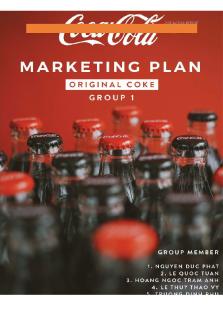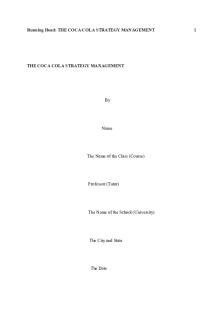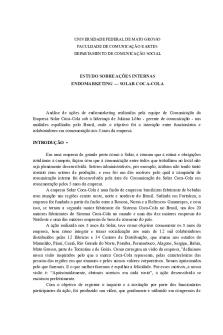Coca Cola Corporate Strategic Plan PDF

| Title | Coca Cola Corporate Strategic Plan |
|---|---|
| Author | Eizzel Samson |
| Course | Accountancy |
| Institution | Adamson University |
| Pages | 15 |
| File Size | 299.8 KB |
| File Type | |
| Total Downloads | 113 |
| Total Views | 170 |
Summary
Download Coca Cola Corporate Strategic Plan PDF
Description
COCA COLA COMPANY’S CORPORATE STRATEGIC PLAN (2020-2024)
A Case Method
ESTER V.PALAÑA MYLENE G. DE VEYRA AYESSA G. GUY-JOCO LAWRENCE A. DIDULO APRIL ROSE T. REMOLLENO 2020
DISCLAIMER This Case Method is for academic discussion only and comprehensive demonstration of the students’ learning acquired from Corporate Planning and Strategic Management Course as a requirement for the degree of Master of Management in Asian Development Foundation College. Financial data presented are not officially reported and not for referencing. For official, audited and reported figures, please contact Coca Cola’s Investors’ Relations.
-Proponents-
Rannie C. Agustin, Consultant
EXECUTIVE SUMMARY A. Company / Business Name and Background Coca-Cola FEMSA Philippines Incorporated Coca Cola FEMSA Philippines Incorporated bottles and distributes soft drinks. The Company operates multiple production facilities. Coca Cola Bottlers conducts business throughout the Philippines. It is owned by majority of Coca Cola FEMSA Mexico.
Coca-Cola FEMSA, S.A.B. de C.V. (BMV: KOFL, NYSE: KOF) (“CocaCola FEMSA” or the “Company”), the largest Coca-Cola franchise bottler in the world by sales volume, announces results for the first quarter of 2020.
B. Corporate Teams
“At the start of the year, we faced a mixed macroeconomic environment across our operations, coupled with a new tax environment in the Philippines. However, our ability to adapt to ever-changing market and consumer dynamics, combined with our transformational initiatives, enabled us to deliver comparable revenue and operating cash flow growth of 7.2% and 4.0%, respectively. By leveraging our clear strategy, the encouraging recovery of our South America division, a resilient Mexico, and an adaptable Philippines, we aim to continue Coca-Cola FEMSA’s growth, while hitting new milestones in transforming our operating model, protecting our short-term results, and ensuring sustainable social and economic value for all of our stakeholders,” said John Santa Maria Otazua, Chief Executive Officer of the Company. 1. James Quincey, Chairman & CEO, Coca Cola Company [email protected] 2. John Sta Maria Otazua, CEO Coca Cola FEMSA Mexico 3. Gareth McGeown, CEO, Coca Cola FEMSA Philippines
ii
AUDIT COMMITTEE 1. David B. Weinberg 2. Marc Bolland 3. Caroline Tsay COMMITTEE ON DIRECTORS AND CORPORATE GOVERNANCE 1. Maria Elena Lagomasino 2. Ana Botín 3. Barry Diller
EXECUTIVE COMMITTEE 1. James Quincey 2. Herbert A. Allen 3. Barry Diller
FINANCE COMMITTEE 1. Barry Diller 2. Herbert A. Allen 3. Ana Botín 4. Chris Davis 5. Bobby Kotick
C. Case Summary 1. Strategic Goals Strategic goals of Coca Cola Company consist of vision, mission, culture and objectives. 1.1.
Vision
Vision Statement Beverages for Life. iii
Our vision is to craft the brands and choice of drinks that people love, to refresh them in body & spirit. And be done in ways that create a more sustainable business and better shared future that makes a difference in people’s lives, communities and our planet. “This has three connected pillars:” “LOVED BRANDS;” “DONE SUSTAINABLY;” and “FOR A BETTER SHARED FUTURE.” 1.2.
Mission
Mission Statement Refresh the world. Make a difference. It is literal and metaphorical statement. “It’s uniquely us. It’s why we exist, and it is needed now, more than ever. In doing so, we must think expansively. It’s about how we refresh people in both body and spirit. It’s about how we refresh the planet and limit the footprint we leave behind. It’s about how our business system refreshes the communities we serve. It’s about how we and our bottlers refresh, inspire and develop the people who work with us.” -Chairman and CEO James Quincey 1.3.
Culture and Objectives 1.3.1. Culture Coca Cola Bottlers Company is shaped by their company culture
expressed as shared values that serve as a compass for our actions and describe how we behave in the real world. Chairman and CEO James Quincey has said, “achieving a vision also means nurturing a culture that makes it possible. Culture is multi-faceted, though it’s ultimately about the right behaviors for each situation. It’s an expression of iv
who we are. This is hard to define in its entirety. While there are many valuable aspects of our culture, we’re calling out two behaviors that will make the biggest difference. “ ACTING WITH A GROWTH MINDSET. This means taking an expansive approach to what’s possible. It’s the essential, animating force behind building a better future. • Curious. • Empowered. • Inclusive. • Agile. BEING CLEAR ABOUT THE CONSCIENCE WE FOLLOW. We start with facts, based in science. The reality of our success and scale is that we have to lead, to be a force for progress and for good. We have a long history of acting with honesty and integrity. People expect us to act as leaders. When we’ve fallen short, we’ve made corrections. If we make mistakes, we act quickly to make things right. In an ever-more interconnected and transparent world, a clarity of conscience to do the right thing is a valuable compass. 1.3.2. Objectives 2020 Targets include the following:
1. Net Income Growth of 4 to 6% 2. Operating Income Growth of 6 to 8% 3. Earnings per Share Growth of 7 to 9% 1.4.
Strategies As Coca Cola continues its journey as a total beverage company, building
loved brands through: v
1.
Disciplined portfolio growth
2.
Brand-building
3.
Innovation
4.
Metrics and routines
5.
Consumer-Centric M&A
6.
Revenue Growth Management (RGM)
7.
Execution.
The Path to Quality Leadership Building sustainable, strong brands requires different strategies of execution in the market based on the brand’s stages of growth. Our goal is to grow our brands from Explorer, to Challenger, to ultimately the Leader in it’s category in a given market, meeting defined success criteria along that journey. On average, brands with Leadership status have margins 1.5 times greater than the nearest competitor. Disruptive Explorer Disruptive Explorer brands have entrepreneurial audacity and the ability to disrupt markets where they are either nonexistent or irrelevant. Patient Challenger Patient Challenger brands work to amplify their competitive edges by focusing on consumer segmentation that matters, like behavior, values and lifestyle, and investing in experiential brand building. Purposeful Leader Purposeful Leaders are representative of wisdom and courage and have the opportunity to expand growth, capture value, and nurture the competitive edge. Highly Diversified with Strong Pricing Power through Pervasive Distribution One component that makes the beverages industry especially attractive is that it is diversified across multiple channels with strong pricing power both in the developing and developed world.
vi
All the bottling partners work closely with their customers such as convenience stores, grocery stores, movie theaters and street vendors to create and use localized strategies developed in partnership with the Company.
C. Industry and Market Analysis 1. Coca Cola Operational and Financial Highlights (1Q 2020) 1. Revenues declined 3.2%, impacted by an unfavorable currency translation effect, while revenues DECLINED by 7.2% for the 1 quarter 2020, impacted by COVID crises. 2. Volume increased in key Cities driven by the rollout of our portfolio and
affordability
initiatives,
while
transactions
outperformed
volumes in key markets. 3. Operating income declined 3.4%, while comparable operating income declined 1.1% for the quarter, driven mainly by cost pressures in the Philippines (sweetened tax included), partially offset by raw material tailwinds in the region. 4. Majority net income decreased 59.0% during the first quarter of 2020, as compared to the same period of 2019 which included a one-time non-cash gain related to the consolidation of the Philippines.
Coca Cola must adapt to new environment brought by COVID 19, social distancing and lockdowns which affect the company’s Q1 sales and income.
2.2. Industry Analysis The Coca-Cola Company’s worldwide volumes have declined around 25% during Coronavirus lockdown, with almost all that decline coming from awayfrom-home channels. “The ultimate impact of coronavirus on 2020 is unknown at this time,” says Coca Cola (Arthur, 2020). vii
All players are affected by social distancing and lockdown measures taken by local and national governments. 2. Market Description "Softdrinks Market" description provides a picture about expansive manufacturing information ---Softdrinks Market Size and Improvement Rate Analysis, Ingress, Transfer and Resident Consumption Analysis. Softdrink, any of a class of nonalcoholic beverages, usually but not necessarily carbonated, normally containing a natural or artificial sweetening agent, edible acids, natural or artificial flavors, and sometimes juice. Natural flavors are derived from fruits, nuts, berries, roots, herbs, and other plant sources. Philippines market revenue in the Soft Drinks segment amounts to US$9,494m in 2020. The market is expected to grow annually by 10.7% (CAGR 2020-2023) (Statista.com) Health and wellness continued to be one of the main trends for soft drinks in 2018 with consumers increasingly looking for no or low-sugar drinks, healthier thirst-quenching drinks. The thirst for premium products shows no sign of abating and premiumisation isn’t one dimensional. It can mean better quality products, more premium serves or packaging, or embody a more social purpose (environmental, socially conscious products). The diversity of shopper missions within the market has led to sales growth coming from a variety of sources. The bulk of value growth has been delivered by the biggest soft drink segments, despite some of them being more exposed to higher risk due to the sugar levy, including cola +11.3%16, energy +8.5%16 and water +5.1%16. Many of the smaller, natural product categories also delivered strong growth, including cold hot drinks +33.2%16 (driven by Lipton), natural energy +32%16 (driven by Purdey’s) and ‘water plus’, up viii
+4.5%16. Take-home also delivered a sterling performance, growing by +12.2%16. Soft drinks continue to play an important role in convenience store sales, driving value and assisting with average weight of purchase opportunities across multiple shopper missions. Soft drinks shoppers are more valuable to convenience stores than the average shopper too, picking up 30% more items and spending more per trip. Soft drink purchases have consistently increased over the past 10 years to and are now at 18% total of convenience market sales, the highest of all categories. The Tax Reform for Acceleration and Inclusion (TRAIN) of the Philippines law imposed taxes on sweetened beverages. Those using sugar are slapped a lower rate of P6 per liter while those using high fructouse corn syrup (HFCS) are taxed P12 per liter. These cover energy drinks, powdered juice drinks and soft drinks. Pepsi Cola Products Philippines Inc. earlier announced it was shifting to using 100 percent sugar in its products from the previous mix of 60 percent sugar and 40 percent HFCS. Coca-Cola Femsa Philippines Inc. have followed suit. The new tax structure also doubled the rate on imported sugar. D. Recommendations 1. Strategies The following strategies and alternative course of actions adjusting and responsive to the COVID 19 crisis and other political and legal pressures of sweet tax:
ix
All Corporate Strategies included in Corporate Plan for 2020 and beyond will continue with some modification responsive to market dynamics affected by sweet tax and social distancing and lockdowns. These are the following: Value-creation 1. Accessible Market/Strategic Positioning and value chain. Support to geographical channels that contract e-commerce which facilitates order and delivery transactions online.
2. Cost efficient raw-materials (by Entrepreneurship). Organising sugar and corn small farmers in Ormoc, Kananga and Tarlac, etc. and provide them a development capacity program including funds and technology for value chain development for sugar and fructuous corn syrup supplies. Unrelated diversification--- entering a different business with a lot of horizontal interaction---comes from vertical relationship between corporate office and business units. Unrelated Diversification- vertical relationship -- Parenting and Portfolio analysis
1. Parenting—positive contribution of the corporate office to the new businesses as a result of expertise and supports. 3. Portfolio Analysis---to absorb some risks in business by other businesses with lower risks. Seasonal or occasional businesses are complementing each other during off and peak seasons.
Coca-Cola has made a yearly commitment to large ad spends. It commitment to advertising has been fairly consistent between 2015 and 2019, spending an average of $4 billion each year to market its drinks to consumers x
around the world. The company spent roughly $4.25 billion on global advertising in the 2019 fiscal year—a big chunk of which went to market Coke (Investopedia). The Coca-Cola Company is looking to cushion the Covid-19-led decline of its bars and restaurants business by reducing marketing costs globally, and, in some markets, coming “off-air” Despite
the
company’s
skepticism
over
brand
marketing
during
coronavirus, it is making a concerted effort to enhance its presence on the shelf. The company has “redeployed” its ground sales reps and trained them in merchandising. Coca-Cola has thus cut brand marketing – partially to reduce costs and partially because it is skeptical of return on marketing investment at this time. Instead of spending money on advertisements, Coca-Cola Philippines will instead “re -channel” P150 million of their budget to help coronavirus disease (COVID-19) relief and response efforts. Coca-Cola will re-channel P150 million to the following efforts: provision of protective equipment and beverages for health workers, delivery of food packs to the most vulnerable families, and support for affected small retailers. 2. Costs 1. E-Commerce will incur no cost for they will be carried by distributor and dealer partners. Coca Cola’s MIS is ready accommodate their orders. 2. Entrepreneurial contracts with small farmers will have a budget of PhP200 million. 3. Off-air and COVID 19 Emergency Response will remain at PHP 150 million 3. Expected Outcome
1. Financial Growths (2020, adjusted from 1Q 2020 results) 1. Net Income Growth of 4-6%%, 4Q 2020 (6-10%, 2021-2024) 2. Operating Income Growth of 6-8% xi
3. EPS Growth of 8-10% 2. Operational Changes 1. safe and quicker on-time delivery than rivals, 2. safe and shorter design-to-market times than rivals, 3. lower costs than rivals, 4. higher product quality than rivals, 5. wider geographic coverage than rivals, 6. achieving technological leadership, 7. consistently getting new or improved products to market ahead of rivals.
xii
E. Financial Statements Income Statement 2020-2024 Projection 1Q 20
2020
6,137.60
23,936.64
25,851.57
27,919.70
30,711.67
33,782.83
Volume (million unit cases) (2) Average price per unit case (2) Net revenues Other operating revenues Total revenues (3) Cost of goods sold
907.8 50.69 49,596 117 49,713 27,796
3540.42 2569.4761 193,424 456.3 193880.7 108,404
3,823.65 2,775.03 208,898.35 492.80 209,391.16 117,076.75
4,129.55 2,997.04 225,610.22 532.23 226,142.45 121,759.82
4,542.50 3,296.74 248,171.24 585.45 248,756.69 127,847.81
4,996.75 3,626.41 272,988.37 644.00 273,632.36 134,240.20
Gross profit
21,917
85,476
92,314.40
104,382.63
120,908.88
139,392.16
Operating expenses
15,934
62,143
67,114.01
72,483.13
79,731.44
87,704.59
51
198.9
214.81
232.00
255.20
280.72
49 5,883 62
191.1 22,944 241.8
206.39 24,779.20 261.14
222.90 31,444.60 282.04
245.19 40,677.05 310.24
269.71 51,137.15 341.26
12
36
38.88
41.99
46.19
50.81
2,012
7,847
8,474.54
9,152.51
10,067.76
11,074.53
414
1614.6
1,743.77
1,883.27
2,071.60
2,278.76
1,598
6,232
6,730.78
7,269.24
7,996.16
8,795.78
Foreign exchange loss (gain)
228
889.2
960.34
1,037.16
1,140.88
1,254.97
Loss (gain) on monetary position in inflationary subsidiaries
-
-
-
-
-
-
246
959.4
1,036.15
1,119.04
1,230.95
1,354.04
Comprehensive financing result
2,072
8,081
8,727.26
9,425.45
10,367.99
11,404.79
Income before taxes
3,737
14,574
15,740.24
16,999.46
18,699.41
20,569.35
Income taxes
1,196
4,664
5,037.55
5,440.56
5,984.61
6,583.07
Net income
2,541
9,910
10,702.69
11,558.91
12,714.80
13,986.28
Net income attributable to equity holders of the company Non-controlling interest Operating income (5) Depreciation
2,414 127 5,883 2,353
9,415 495.3 22,944 9,177
10,167.77 34.92 24,779.20 ,910.84
10,981.19 77.72 26,761.53 10,703.70
12,079.31 635.49 29,437.68 11,774.07
13,287.24 699.04 32,381.45 2,951.48
470
1833
,979.64
,138.01
2,351.81
,586.99
8,706
33,953
36,669.67
39,603.25
43,563.57
47,919.93
Transactions (million transactions)
Other operative expenses, net Operative equity method (gain) loss in associates(4) Operating income (5) Other non operative expenses, net Non Operative equity method (gain) loss in associates(6) Interest Expense Interest income Interest expense, net
Market value (gain) loss on financial instruments
Amortization and other operative non-cash charges Operating cash flow
(5)(7)
xiii
2021
2022
2023
2024
Balance Sheet 2020-2024 Projection
20-Mar
2020
2021
2022
2023
2024
Assets Current Assets Cash, cash equivalents and marketable securities
19,549
21,112.92
22,801.95
24,626.11
27,088.72
29,797.59
Total accounts receivable
13,132<...
Similar Free PDFs

Coca Cola Corporate Strategic Plan
- 15 Pages

Coca Cola Strategic Management
- 5 Pages

Coca Cola Marketing Plan
- 11 Pages

Coca cola
- 7 Pages

Coca Cola-SWOT - Coca Cola-SWOT
- 4 Pages

PROCESO ADMINISTRATIVO COCA COLA
- 1 Pages

COCA-COLA CASE STUDY
- 13 Pages

Coca Cola Strategy Management
- 9 Pages

Endomarketing - Solar Coca-Cola
- 5 Pages

Coca cola case study
- 2 Pages

Coca Cola Sustainability
- 11 Pages

Synthèse exposé coca-cola
- 2 Pages

Coca-cola - final summary
- 2 Pages

COCA COLA assignment official
- 15 Pages
Popular Institutions
- Tinajero National High School - Annex
- Politeknik Caltex Riau
- Yokohama City University
- SGT University
- University of Al-Qadisiyah
- Divine Word College of Vigan
- Techniek College Rotterdam
- Universidade de Santiago
- Universiti Teknologi MARA Cawangan Johor Kampus Pasir Gudang
- Poltekkes Kemenkes Yogyakarta
- Baguio City National High School
- Colegio san marcos
- preparatoria uno
- Centro de Bachillerato Tecnológico Industrial y de Servicios No. 107
- Dalian Maritime University
- Quang Trung Secondary School
- Colegio Tecnológico en Informática
- Corporación Regional de Educación Superior
- Grupo CEDVA
- Dar Al Uloom University
- Centro de Estudios Preuniversitarios de la Universidad Nacional de Ingeniería
- 上智大学
- Aakash International School, Nuna Majara
- San Felipe Neri Catholic School
- Kang Chiao International School - New Taipei City
- Misamis Occidental National High School
- Institución Educativa Escuela Normal Juan Ladrilleros
- Kolehiyo ng Pantukan
- Batanes State College
- Instituto Continental
- Sekolah Menengah Kejuruan Kesehatan Kaltara (Tarakan)
- Colegio de La Inmaculada Concepcion - Cebu

